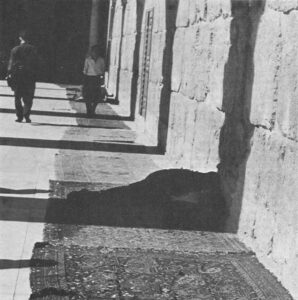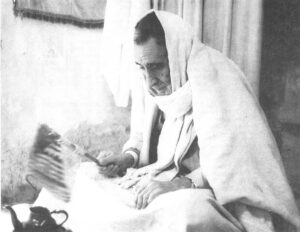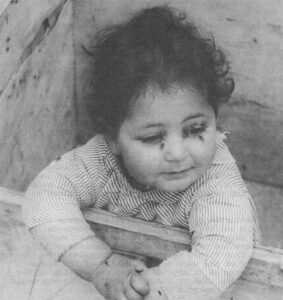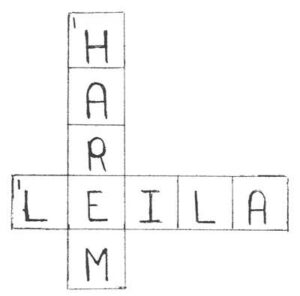February 1971
A visit to Palmyra, Syria, where Queen Zenobia, one of the greatest women in history, once ruled an empire stretching from Asia Minor to Egypt, is enough to discourage even the most dedicated women’s liberation activist. Women in Palmyra have come a long way since the Third Century A.D. when one of their sex ruled a queendom that challenged even the Romans. But it seems they have gone most of their way in reverse.
Queen Zenobia may be an attractive symbol for women’s liberation in the Western world, but her soul sisters in Palmyra do not appear to care. Indeed, in public, women do not appear at all – even during the prime social hour, early evening. In this oasis town in the Syrian desert, the dozen or so ahwes (a cross between cafe and men’s social club) are filled with Arab men sipping Turkish coffee, talking and playing backgammon. Meanwhile, except perhaps for a young girl with her grandfather or an elderly woman, a female never goes out at night. Most of the time, she is confined to her father’s or husband’s house, especially if she is between the ages of eighteen and forty when otherwise she would be most fit to deal with the world beyond her front door.
Women do appear in daytime, but they must view the world through a thick, black, chiffon scarf that covers the entire head and face. The veil, a means of guarding female sexual modesty, is a bourgeois device. And since Palmyra is big enough – between five and ten thousand inhabitants, depending on who is counting – to qualify as a town, the veil is employed. More emancipated townswomen wear scarves carefully folded to cover every lock of hair.
In smaller villages than Palmyra, peasant women casually wear head kerchiefs, which allow the hair to show. Their harsh, physical labor on the land precludes the citified luxury of veiling; otherwise if veiled, they would be restricted to the house and the working population would be cut in half.
Bedouin women are the freest of all. If they cover the face and head, it is for the same reason that the men folk wear the kufiya (standard Arab head gear; a long cotton scarf draped over head and shoulders) – not as protection of family ‘ird (sexual honor) but simply as protection from severe, desert weather.
Taking veiling practices as a rough index of the condition of females in a given society and studying Palmyran temple bas-reliefs picturing women from Queen Zenobia’s time, one may conclude that although the Queen is assigned a great place in history, actually her independence was probably as exceptional in ancient Palmyra as it would be today. One pre-Islamic bas-relief depicting a procession led by a cameleer and trailed by three walking women covered from head to toe in elaborate, swirling veils and gowns suggests that the Arabs of metropolitan Palmyra – whose impressive, Roman-style temples, theatre, agora, boulevards, etc., can still be seen today – were restricting their women behind veils. Since these ruins date almost four centuries before Islam, they also suggest that it is unjust to blame Islam for introducing the veil.
Queen Zenobia, whose beauty classic writers claim rivaled Cleopatra’s, attained the throne by inheritance not by overcoming sexual discrimination. She assumed the hegemony of her assassinated husband and ruled in her son’s name.
Once in power, however, she proved to be such a strong, ambitious female that the Roman Emperor Aurelian felt compelled to defeat Palmyra, his former ally. According to legend, Zenobia was taken to Rome, bound in chains appropriately fashioned from gold. She was made to follow the Emperor’s triumphal chariot.
To this day, it seems women in 2almyra are expected to be as submissive as the enchained Zenobia. Several weeks ago for example, a young Palmyra woman gave birth to her eighth child. While she stayed home tending her baby and seven other children, her thirty-four year old husband went for a visit on his bicycle – his heavy, dark robe and gray and white kufiya, held in place by an ‘ajal (a black, halo-like rope), ballooning in the desert wind. “I am Hajj Khalil.” “The name ‘Hajj1’, he boasted, “means that I have made the pilgrimage to Mecca.” He is also Palmyra’s dairyman – “I make ‘arab butter which means it’s butter from goat’s milk.”
Although Hajj Khalil would rarely aid his wife around the house, he helped his host stir the fire to boil water for a pot of extra sweet, mint tea.
Setting down his second cup of tea and muttering dayme (meaning “may you always be capable of extending such hospitality,” the proper expression to tell your host who finishes serving tea or coffee), Hajj Khalil quickly turned the conversation to the subject of his family – or rather to that part of the family which counted – the males.
Asked how many children he had, he replied that he had six boys. He later remembered to add his two girls. “The more children the better,” he declared.
“And what if you had all girls?” another guest asked.
“All girls,” he replied, “hatha musibah – that is a catastrophe.” His answer reflected social dictates preventing girls, unlike boys, from earning a living. Girls are consequently considered economic liabilities even though they work as hard as men guaranteeing the family’s food, shelter, and clothing.
Hajj Khalil contrasted himself, a family man, with his host, bachelor Muhammad Mojamed. While Khalil spoke only Arabic, Muhammad claimed to speak Russian, English, French, and Arabic; a BBC broadcast accompanied the tea service. Khalil had a stubbly beard. Muhammad’s reddish hair and moustache were neatly groomed, and he wore a sport coat, tie, and trousers. But despite Muhammad’s modern dress, his views on women were as traditionalist as Hajj Khalills.
Muhammad Mojamed is gatekeeper of the great Temple of Zenobia, yet like the rest of contemporary Palmyra, he seems unimpressed with Zenobia as a woman. Asked about the possibility of another woman like the Queen coming to power, he replied, “This won’t happen today.
Why? “People would refuse this.”
Why? “Different people have different ideas. Now they don’t want such a thing.”
Why? “I know. You know. And the rest of us know.” Muhammad Mojamed declined to elaborate on something so basic as female inferiority.
Received in New York on March 4, 1971.
©1971 Paula Stern
Paula Stern, a free-lance writer, is an Alicia Patterson Fund award winner. This article may be published with credit to Ms. Stern and the Alicia Patterson Fund.










